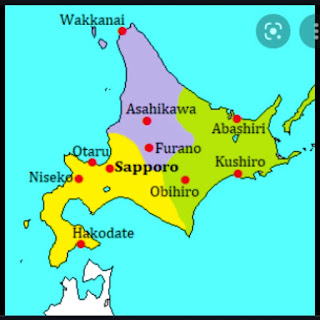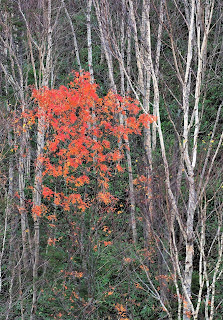Falling for the fall colours in Hokkaido, Japan in 2018
Part 1
(Travel Story Series @ Hon Too Fang 2021)
From 8th to 21st October 2018 we were on a group tour to Hokkaido, Japan. This is the straight forward travel story, memory in the old written form.
1 - Hokkaido info
Hokkaido is the 2nd biggest island in Japan and it lies to the north. It has an area of about 83,000 sq km, or about 70% the size of our Sarawak. Population 5.4 million. Hokkaido is a prefecture in Japan and administratively it is divided into 15 sub-prefectures. The economy of Hokkaido is heavily dependent on the service industry: like trade and commerce, education and tourism. In agriculture it has a quarter of Japan’s farmland. It produces about 15% of the nation’s farm produce and 22% of sea catches.
2 - Sapporo
We flew with Air Asia from KL to Sapporo, greeted by Doraemon and a giant flower ball at the New Chitose Airport.
Tanukikoji Street
Sapporo is the capital of the prefecture, with a population near to 2.0 million. The main shopping street of Sapporo is the 1 km long covered Tanukikoji Street. The last photo shows a nearby street with many advertisement boards.
Nijo Ichiba
Nijo Ichiba is the traditional seafood centre, over 100 years old. There are about 60 shops. The crab dumpling cost 500 ¥ each, just over RM 18. Size and filling of the real one are way short of the sample portrayed in the poster. The Japanese also cheat. The squid dinner set at RM 40 is value for money. The king crab is sold at 7,500 ¥ each, or RM 270. The popular Furano melon, a Hokkaido special, sells for 2,500 ¥ each, or RM 90. So the first lessen we learn in Hokkaido is what is meant by expensive in Japan.
Visited the former Hokkaido Prefectural Government Building which is a Western-style red brick building with a well-kept garden.
3 – Self-drive tour
We are on a self-drive tour. 16 people in 3 Toyotas, 2 are 7-seaters. Members volunteer to take turns to drive. I am the oldest, so exempted from active duty or may be they don't trust my driving. First: briefing by the tour leader, Rachel, "remember, I am the boss.....".
4 – Furano / Biei
Furano and Biei are 2 towns in the Kamikawa sub-prefecture in central Hokkaido. They are famous for flower farms and scenic rural landscape. They are 35 km apart. Farms and sights visited would be put together under this combined heading as we are not sure each specific place belongs to which town.
Farm Shikisai-no-oka
Farm Shikisai-no-oka, or Farm at Four Season Hill, is a farm with colourful fields. Shown the ornamental cabbage. The white plant is silver dust or silver ragwort.
Farm Tomita
Farm Tomita, established in 1903, is famous for their lavender fields in mid-summer (late June to early August). In October the area with lavender is greatly reduced, just enough to keep tourists happy, 1st photo. The lavender ice cream is famous and really great too. The last photo shows the showy celosia, nick-named cock’s comb.
Sunflowers at Zerubu
Passed by a field of sunflowers at Zerubu, with blooming chrysanthemum.
Blue Pond
Visited the Blue Pond, which looks more greenish than bluish though. It was built for flood mitigation purpose but unexpectedly turned out to be a tourist attraction. With 2 cute canine visitors even. The area has not shown much autumn colours yet but we still found 2 photographers with long zooms trying to capture their dream shots. Better days are coming, our tour leader says. Coincidently, the leaders of the PH parties say the same thing.
Shirahige-no-taki
The Shirahige Falls is over a gorge in Biei. The waterfalls is unique in that the source water comes out from underground. Further up is a small hill with a park, with our members practising their iconic YonGo pose. Shown also a beautiful autumn setting with a bridge in the neighbourhood.
Ningle Terrace
Went to Ningle Terrace in the early evening. It is a collection of 14 timber cottages selling products in arts and crafts, nestled among pine trees. Leaves are creatively swept into a heart-shaped heap. Cool.
Other places
We visited a cheese factory and a wine brewery. Also a small Inari Shrine associated mainly with the god of rice, with the iconic red troii (gate) and the statues of foxes, the key holder of rice barns.
5 – Asahidake Onsen
From Furano we went north to the small hot spring town of Asahidake Onsen within the administration of the city of Asahikawa. It is located in the Daisetsuzan National Park, the largest national park in Hokkaido where the island's highest mountain, Mt Asahidake is located. The height of Mt Asahidake is 2,291 m.
We took the Asahidake Ropeway and went to the upper station and hiked for about 3 km. A cloudy and misty afternoon, with only a glimpse of clear sky now and then. Could not see far at all and so no clear view of the mountain peaks. Very few clear shots of the scenery. Because of high wind, pines and bamboos here turn into dwarf species, not more than a meter and a half tall, 5th photo. At the station there is cleaning facility for dirty shoes. Excellent service, only in Japan.
6 – Asahidake Onsen to Sounkyo Onsen
Our next stop is Sounkyo Onsen, another hot spring town within the Daisetsuzan National Park, but further north. The straight-line distance between these 2 towns is less than 20 km, but the road link is about 145 km and it took us the whole morning. But the time was not wasted. Along the journey were several spots with great landscape and autumn colours.
7 - Sounkyo Onsen
Sounkyo Onsen is located at a valley. It is the gateway to the Daisetsuzan National Park via the Kurodake Ropeway. Shown the neighbourhood near the base station of the ropeway.
Photos taken while on the ropeway. The smiling face in the 1st photo is not our member. She is Malaysian though, on self-drive tour, alone. Cheers.
Scenery at the upper station of the ropeway. The main peak is Mt Kurodake, 1,984 m high. Mt Kurodake is one of the earliest places in Japan to experience autumn, starting around mid-September. So by mid-October, at the time of our visit, some trees were almost leaf-less, like already in early winter. Weather today is still not helpful, mostly cloudy with drizzles. No stunning scenery shots to show too. Nevertheless, the full range of autumn floiage is exhibited, from trees with red leaves to no leaves.
8 - Abashiri
From Sounkyo Onsen we went to Abashiri, 130 km to the north-east. It is a coastal town in northern Hokkaido, population 40,000. First we went to the Abashiri National Park to look at the unique red glasswort plant. The scientific name of the plant is Salicornia, a succulent, salt-tolerant flowering plant with the foliage turning red in autumn. But the season was over. Not many we could find, with one shown in the 2nd photo. No spectacular sea of red to shoot an award-winning photo.
Cape Notoro
Next the scenic coast and Cape Notoro, which is a famous shooting location for filming movies and advertisements.
Abashiri Prison Museum
The niche Abashiri Prison Museum is converted from an old prison at the same site. Isn't the inmate in this high security single cell look like Ah Jib Ko? Exhibits include handcuffs and leg shackles, and wax-figures of prisoners having a meal. Do note that not all in the last photo are prisoners.
9 – Kiyosato
Kiyosato is a small town to the south-east of Abashiri. We stayed in the new Kiyosato Ihatov Youth Hostel. Yes, youth hostel for those in the young age of 50s and 60s. Next to this isolated hostel is a farm for Mexican yum bean, 沙葛in Chinese or bangkuang in bahasa.
Sights nearby
Sights nearby include the Oshinkoshin Waterfalls, one of the top 100 waterfalls in Japan. The local sika deer could be found by the roadside and parking lots. Then at the Ochu Observation Tower which is a simple 3-storey timber tower with a bell at the top level. Great panoramic view of the surrounding.
10 - Shiretoko National Park
The Shiretoko National Park is a UNESCO World Heritage Site, about 60 km from our hostel in Kiyosato. Within the park are 5 small lakes created a long time ago due to volcanic eruption. From the Visitor Centre, there is an 800-m long elevated timber boardwalk to the first lake. The track to other lakes are at ground level. We spent 2+ hours hiking along the famous 5-lake route, about 4 km long.
And the lakes, similar but different.
And samples of autumn colours. It is strange that the leaves of the evergreen pine tree also turn yellow. Die together or mourn in sympathy!
King crab dinner
Shiretoko is a coastal town. Ordered a king crab as part of our dinner, cost near to RM 300. The ones shown are not cooked yet. Cooking means steaming. After it is steamed, just dip the meat in soya sauce. That brings out the original sweet taste of fresh crabmeat. Not your chilli crab, or sweet-n-sour or “kamhiong”. Those are 3rd grade cooking despised by the Japanese. At RM 300 each, certainly more expensive than our musang king. The sea king is costlier than the mountain king.
11 - Kiyosato to Obihiro
The next part of the journey is from Kiyosato in the north to Obihiro in the middle of eastern Hokkaido. First stop is Mashu Lake, a caldera. The water depth is up to 200 m, making it one of deepest and clearest lakes in Japan. Beautiful shots because of good weather.
TO BE CONTINUED…..

































































































No comments:
Post a Comment